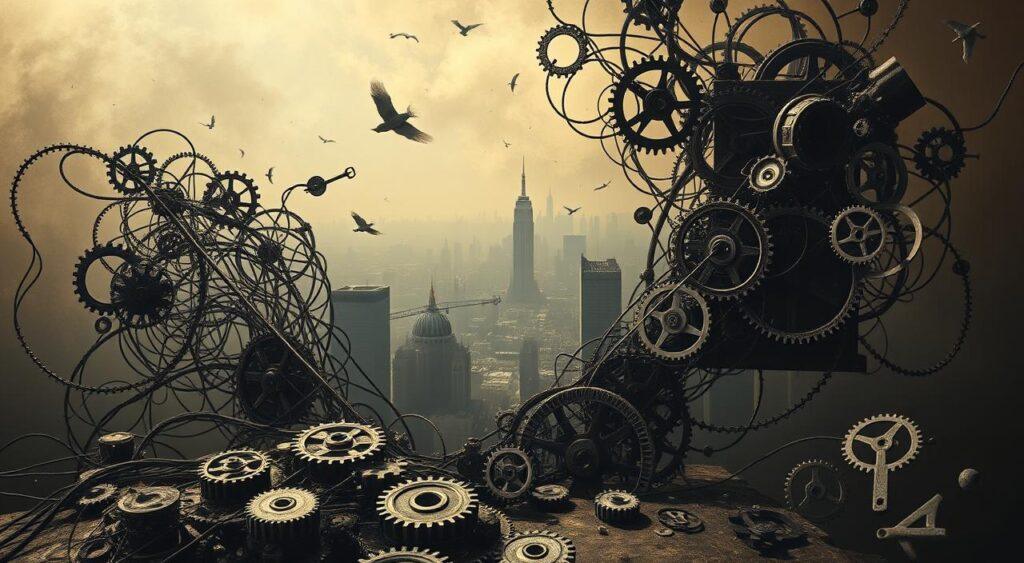Ever made a decision that backfired unexpectedly? Imagine planting a tree to create shade, only to realize it blocks sunlight from your garden. That’s the law of unintended consequences in action—a mental model explaining how purposeful choices often lead to surprise outcomes and unexpected consequences.
This idea isn’t just about mistakes. It’s a rule showing how actions ripple through complex systems. Take history’s Cobra Effect: a bounty program for dead snakes in India led to people breeding cobras for profit, illustrating the unintended consequences of government intervention.
The “solution” made the problem worse, highlighting the power of economics and the ripple effect of actions.
Why does this happen? Systems—like nature, economies, or relationships—are interconnected. Changing one part can trigger hidden effects. For example, safety rules at work might slow productivity, showcasing how even well-intentioned regulations can have adverse results.
Or new tech might solve a problem but create environmental harm, demonstrating the complex interplay of economy and consequence.
Understanding why unintended consequences matter helps us think smarter. By analyzing past events, we learn to spot patterns and ask: “What could go wrong if I do this?” It’s not about fear—it’s about preparation.
Key Takeaways
- Every action can trigger unexpected results, both good and bad, highlighting the power of unintended consequences.
- Complex systems (like ecosystems or markets) amplify hidden effects that can be a significant part of government policy.
- Historical examples include failed policies and tech innovations gone sideways, showcasing the unintended consequences of decisions.
- Thinking ahead reduces risks—ask “What if?” before acting to understand the potential result of your choices.
- Learning from mistakes helps avoid repeating them.
Introduction to Unintended Consequences
Ever wonder why new rules sometimes create bigger problems? Imagine banning plastic straws to save turtles—only to see paper waste triple. That’s how unforeseen results work. They’re the hidden dominoes that fall after any choice.
Defining Unintended Outcomes
Consequences are like shadows—they follow every action. When you take medicine for a headache, it might also lower heart attack risk. That’s a positive surprise! But when cities require bike helmets, fewer people ride bikes—leading to more obesity. Oops.
This analysis of law unintended consequences reveals how unintended consequences can emerge.
People often miss these ripple effects. Why? We focus on what’s right in front of us. French economist Frédéric Bastiat called this “seen vs unseen.” Fixing today’s problem might plant seeds for tomorrow’s crisis, making it crucial to consult reliable sources.
Overview of the Concept’s Evolution
The idea isn’t new. John Locke noticed it in 1691. He saw how capping interest rates made loans disappear. Adam Smith later showed how self-interest could accidentally help everyone—like his “invisible hand” boosting economies.
By the 1930s, sociologist Robert Merton gave it structure. He studied why policies fail. Take the FDA’s drug approval process: strict rules save lives but delay treatments. Some patients die waiting. Today, we use his framework to predict hidden effects before acting.
Good or bad, every choice has aftershocks. Antibiotics save lives but create superbugs. Rent control helps tenants now but reduces housing later. The trick? Look beyond the first domino.
Understanding the Law of Unintended Consequences

What happens when a fix backfires worse than the original issue? Take Japan’s nuclear shutdown after Fukushima. Officials closed 34 plants to prevent future disasters. But guess what? Fossil fuel use jumped 20%, electricity prices soared, and winter shortages caused health risks. Overnight solutions often cast long shadows.
Core Patterns in Action
Three principles explain why surprises happen:
- Hidden chains: Rules designed for one goal (like wildfire prevention) often ignore other factors (deadwood buildup causes bigger fires).
- Time delays: Small effects today—like rushed home renovations—can mean massive repair costs next year.
- System shocks: The 2005 Bankruptcy Amendments tried to reduce filings but led to more failed debt plans. Only 3% stuck with alternatives.
Why This Shapes Your Decisions
Ever heard of the Cobra Effect? It’s not just history.
When cities banned plastic straws, paper waste tripled. Governments aren’t alone—your choices work the same way. Rushing a work project might please your boss now but create errors that damage client trust later.
This is a classic example of law unintended consequences, where well-meaning decisions lead to unexpected results.
Economists call this “the seen vs the unseen.” Fix today’s problem, and you might miss tomorrow’s crisis. Like strict drug laws that accidentally empower cartels.
Every choice—personal or political—has aftershocks. Understanding the law unintended can be a valuable source of insight. Spotting them? That’s the real superpower.
Historical Perspectives and Key Thinkers
History shows even brilliant minds struggle with surprise outcomes. Let’s meet three thinkers who shaped our understanding of hidden ripple effects.
John Locke and Early Observations
In 1691, John Locke spotted a problem with interest rate caps. When England limited loan rates, lenders stopped offering money. Farmers couldn’t buy seeds. Locke saw how policy changes often help one group but hurt another. His lesson? Quick fixes can starve the system they try to feed.
Adam Smith and the Invisible Hand
Ever bought bread without planning to help society? That’s Smith’s invisible hand. In 1776, he noticed bakers and butchers serving community needs—not out of kindness, but self-interest. Markets quietly turn personal goals into shared benefits. But Smith warned: this force works best when policy doesn’t force it.
Marx, Engels, and Social Impact
Karl Marx and Friedrich Engels saw darker patterns. They argued competition pits workers against owners, leading to sabotage and wasted resources. Factories might boost profits but poison rivers. Their insight? Systems built on conflict breed unintended harm—like sparks in a dry forest.
Why does history keep teaching this lesson? Because every choice—whether setting prices or building mills—touches lives in ways no single mind can map. Even geniuses get blindsided. Makes you wonder: what invisible chains might our modern policies create?
Austrian School Views on Unintended Effects
Ever notice how small choices snowball into big changes? Picture coffee drinkers switching to lattes—suddenly oat milk becomes a $4 billion industry. The Austrian School shows how everyday decisions shape economies in ways nobody plans. Let’s explore their eye-opening ideas.
Carl Menger’s Economic Insights
Carl Menger saw power in simple trades. His “marginal utility” theory explains why a thirsty hiker values water more than gold. But here’s the twist: when millions make these choices, markets shift unpredictably. A coffee shop owner raising prices might accidentally fuel oat farm growth across three states.
Menger also spotted hidden risk in every decision. Choosing to build a factory creates jobs—but might pollute a river. Entrepreneurs weigh these trade-offs daily, often sparking development they never intended. Like planting one tree that starts a forest.
Friedrich Hayek and the Concept of Catallactics
Hayek loved patterns that build themselves. His “spontaneous order” concept shows how cities grow without blueprints. Think of busy markets—no boss tells vendors where to set up, yet stalls form logical clusters. Prices act as secret messengers, guiding choices better than any planner.
Central control? Hayek called it risky business. When governments try forcing growth, they often block natural development. Like redirecting a river—you might get a flood downstream. His catallactics theory proves society works best when we let ideas flow freely.
From TikTok trends to crypto booms, we see Hayek’s ideas daily. The Austrian School reminds us: plans are guesses, but human creativity? That’s the real engine of change.
Modern Examples and Real-World Applications
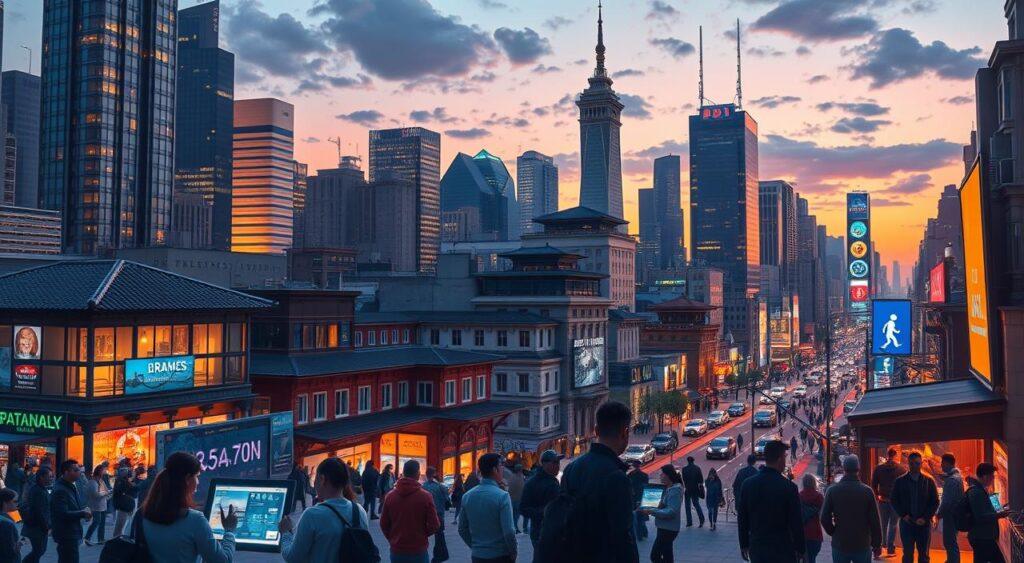
Did you know some rules meant to protect us can actually cause harm? Let’s explore how laws designed to solve problems often create new ones—like fixing a leaky pipe only to flood the kitchen.
Case Study: Regulatory Policies and Economic Impact
Take the FDA’s sesame labeling rule. Meant to help allergy sufferers, it backfired. Food companies started adding sesame to products on purpose to avoid cross-contamination labels. Now allergic shoppers face costs they never expected.
Or consider car safety rules. CAFE standards pushed automakers to build lighter vehicles. Sounds good? Lighter cars led to 2,200–3,900 extra highway deaths over a decade. Safety goals collided with physics.
Legislation Gone Wrong: From Prohibition to Price Controls
Remember the 1920s alcohol ban? It didn’t stop drinking—it created gangsters. Al Capone’s empire grew from this “solution.” Today, rent control laws show similar patterns. Lower rents today mean fewer apartments tomorrow. Landlords convert buildings to avoid losses.
| Law | Intended Goal | Unintended Result | Hidden Costs |
|---|---|---|---|
| Prohibition (1920) | Reduce alcohol use | Organized crime boom | $300M+ in enforcement |
| CAFE Standards | Improve fuel efficiency | More traffic deaths | 3,900 lives lost |
| Sesame Label Rule | Protect allergy sufferers | More sesame in foods | Higher risk for patients |
| Rent Control | Affordable housing | 75% fewer new units | Longer waitlists |
These examples teach us: every rule has ripple effects. Whether it’s taxes on sugary drinks or FBI data rules, good intentions need second-guessing. What seems simple today might spark chaos tomorrow.
Social, Economic, and Political Implications
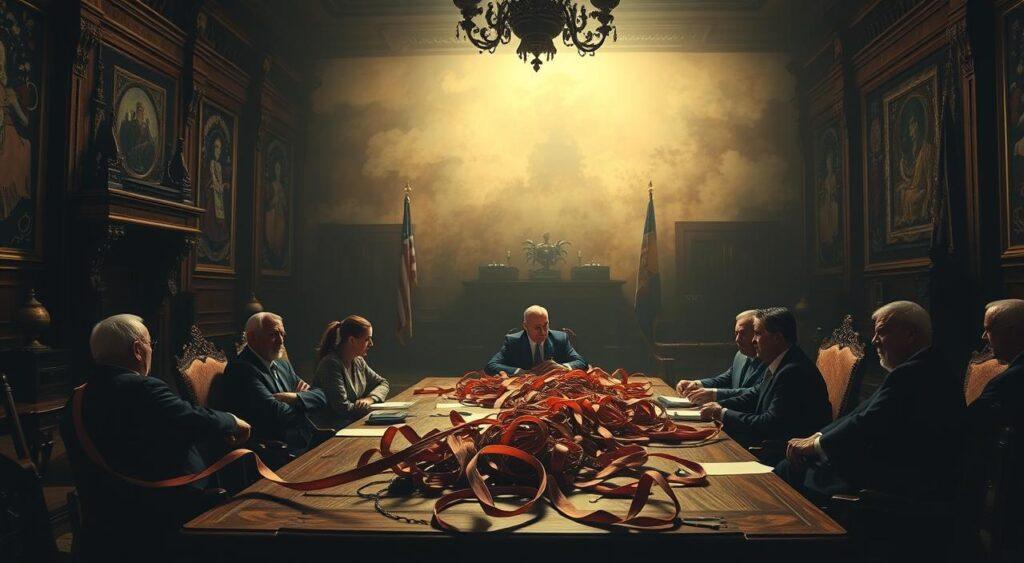
Ever felt like new rules solve one problem but create three more? Picture a teacher banning gum in class—suddenly students trade Pokémon cards instead. Big decisions often spark chain reactions we never see coming. Let’s explore how policies shape wallets, votes, and communities.
Effects on Government Policy and Public Opinion
When the United States taxed sugary drinks, companies switched to cheaper corn syrup. Health goals collided with profit motives. Politicians often focus on quick wins—like cutting interest rates to boost spending. But voters notice when fixes backfire. Rising national debt ($33 trillion) now worries 68% of Americans, shaping elections.
Take Rep. Matt Gaetz’s warnings about debt. His message resonates because people see money decisions impacting jobs and taxes. Policies designed to help—like farm subsidies—sometimes enrich corporations instead of families. Public trust erodes when promises don’t match results.
Ripple Effects in Economics and Society
Remember Kudzu? The U.S. imported this vine to stop soil erosion. Now it chokes native plants across 12 states. Economic choices spread similarly. When the Fed hiked interest rates in 2023, mortgage payments jumped $500/month for many. Renters felt the squeeze too.
Bold moves in the economy—like COVID stimulus checks—kept businesses afloat but fueled inflation. Grocery bills rose 25% in three years. Workers demanded higher pay, causing layoffs. Politicians walk tightropes: every dollar spent or saved sends waves through society.
Here’s the kicker: 74% of voters say leaders ignore long-term interests. Whether it’s climate laws or tech regulations, choices today build tomorrow’s world. Like planting a tree whose roots crack sidewalks years later. The United States’ path forward? Balance boldness with foresight.
Insights from Robert K. Merton
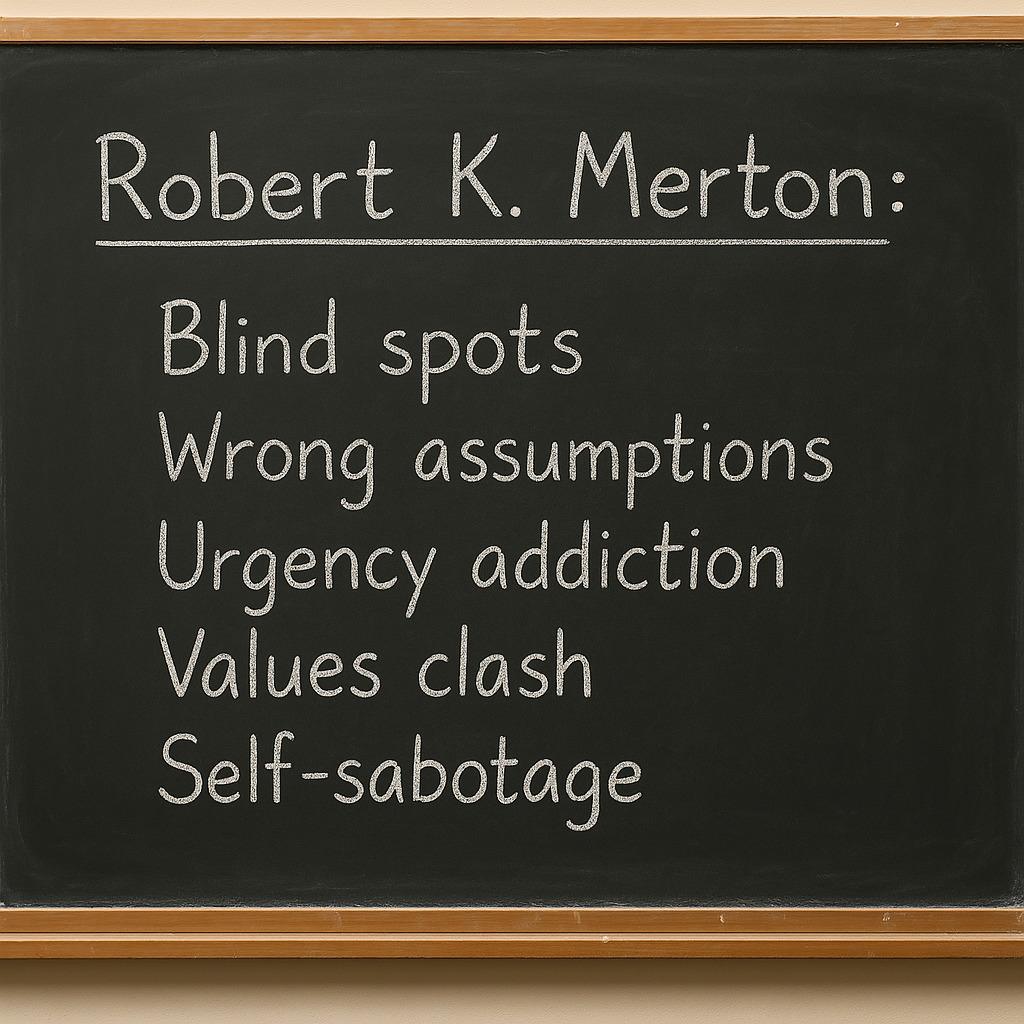
What if your best-laid plans could backfire even with perfect intentions? Sociologist Robert K. Merton spent years studying why smart actions often create messy results. His 1936 research revealed five hidden traps that turn good ideas into surprise outcomes.
Unpacking the Five Sources of Unanticipated Consequences
Merton showed how workable solutions fail when we ignore these factors:
- Blind spots: Focusing only on immediate goals (like boosting crop yields) while ignoring side effects (soil depletion)
- Wrong assumptions: Believing “all shoppers want lower prices” might kill local businesses
- Urgency addiction: Rushing drug approvals to save lives now could mean missing safety risks later
- Values clash: Privacy laws protecting data might hinder medical research breakthroughs
- Self-sabotage: Fear of layoffs causing workers to resist automation… which then causes layoffs
His classic example? Funding Afghan fighters in the 1980s seemed wise during Cold War tensions. But this action helped create terrorist networks decades later. Merton’s strategic planning framework helps spot these traps before they spring.
Here’s the kicker: 84% of policy failures stem from ignoring just one of these five ways. Whether you’re launching a product or planning a career move, asking “What invisible results might this create?” builds better decisions. Like checking for storm clouds before planting a garden.
Social, Economic, and Political Ripple Effects
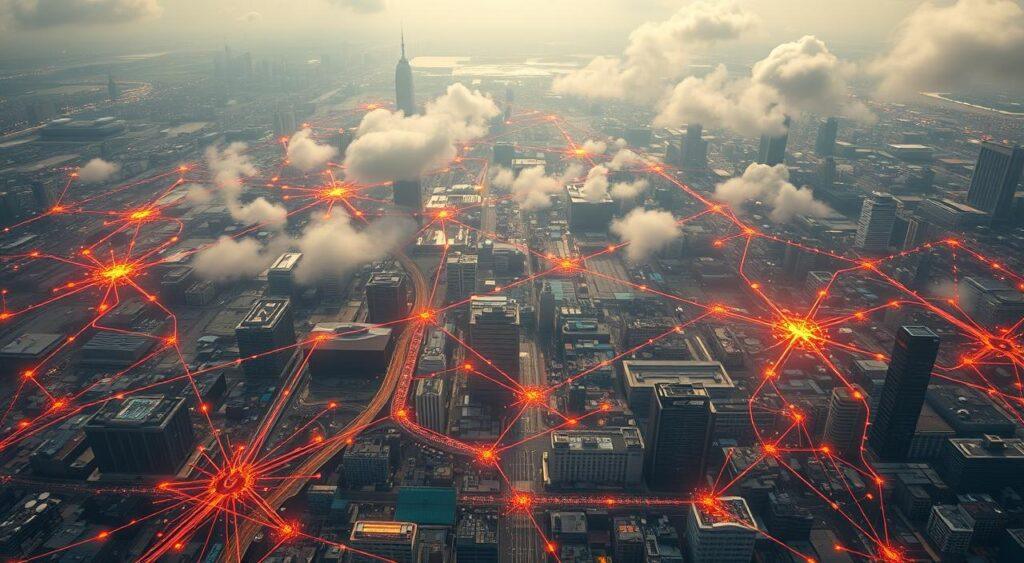
What happens when one small choice shakes the world? In 1859, a farmer released 24 rabbits in Australia for hunting. By 1900, their population exploded to 600 million—destroying crops and ecosystems. This shows how tiny sparks can ignite global wildfires of change.
Case Studies on How Change Spreads
Let’s explore three real stories where actions created chain reactions:
| Event | Initial Goal | Unseen Impact | Time Frame |
|---|---|---|---|
| Rabbits in Australia | Create hunting sport | $2B/year crop damage | 19th-21st century |
| Volkswagen Emissions Scandal | Meet strict pollution rules | 40,000 tons of extra toxins released | 2015-2023 |
| Widened Panama Canal (2016) | Boost ships traffic | Changed global trade routes | 1 decade |
Notice a pattern? The rate of damage often outpaces solutions. Australia’s rabbit population grew 25 million per year. Cities like Sydney now spend millions annually on containment.
Modern examples hit closer to home. When Germany tightened emission rules, Volkswagen cheated—polluting equal to 1.2 million extra cars. Meanwhile, bigger ships using the Panama Canal shifted 15% of Asian trade from California ports to East Coast hubs. Jobs moved. Housing markets shifted.
These world-shaking events started with choices that seemed harmless. Like tossing a pebble that becomes an avalanche. What pebbles are we tossing today?
Conclusion
Choices are like seeds—plant one and watch forests grow where you expected flowers. Our journey through history and modern life shows every action has multiple parts. The $4 trillion COVID relief saved jobs but sprouted inflation weeds.
Buying cheap shoes might save money now… until a sprained ankle becomes the real end cost. This illustrates the law unintended consequences, where decisions can lead to unexpected results for the people involved.
Here’s the big idea: side effects hide in every decision. Napoleon’s march to Moscow. Paper straw mandates creating waste mountains. Even saying “yes” to a date could reshape your life path. We can’t predict all outcomes—but we can plan better. This analysis of choices reveals how the law unintended can manifest in everyday life.
Think of your next move as chess. Ask: “What’s three steps ahead?” Like farmers checking weather apps before planting. Or cities testing traffic patterns before widening roads.
This idea isn’t about fear—it’s about smart preparation. Each decision can serve as an example of how our actions lead to unforeseen consequences.
Now, your turn. Where does this idea fit in your world? Maybe checking a contract’s fine print. Or weighing a career change’s ripple effects. Every place and choice matters.
Because today’s “fix” might be tomorrow’s puzzle. Ready to play the long game?
